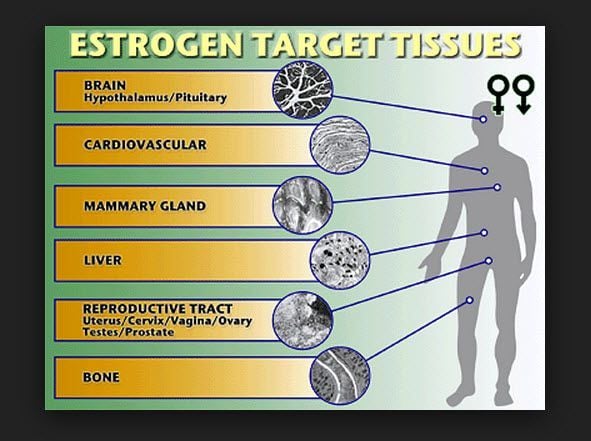Nelson Vergel
Founder, ExcelMale.com
I was able to come up with a table using the predictive model equation derived from data in this study:
The Effects of Injected Testosterone Dose and Age on the Conversion of Testosterone to Estradiol and Dihydrotestosterone in Young and Older Men
The graphs shown in the study (They injected several doses of testosterone enanthate in young and older men) show sensitive estradiol and DHT at different total testosterone blood levels. The curves reach a pseudo plateau at higher TT levels. Older men tended to produce more estradiol and DHT than younger men.

The equation I used was based on a mathematical model shown in this study that included variables calculated from Michaelis-Menten kinetics.
For older men:
E2 (regular immunoassay- not sensitive)= 138.3xTT/(1470.1+TT)
DHT = 269.4xTT/(2389.6+TT)
TT= Total Testosterone
Here is the table I came up with for older men
Of course, as you can see from the graphs above, there is a lot of variability in values, so these predicted numbers are just representing the curve.

Since these estradiol values were immunoassay-based, sensitive (LC/MS) values would be lower. How much lower? We don't know since CRP values were not measured. I would multiply the estradiol numbers in the above table by 0.80 to arrive at a guess for sensitive estradiol values.
These were the baseline characteristics of both groups before they received testosterone enanthate injections. Both groups seemed relatively lean to me.

Treatment protocol:

MAIN MESSAGE: ESTRADIOL AND DHT "NORMAL RANGES" SHOWN BY LABCORP OR QUEST ARE DERIVED FROM MEN WHO DO NOT HAVE HIGH TESTOSTERONE. MANY MEN ON TRT USUALLY HAVE "HIGHER" TESTOSTERONE THAN "NORMAL", SO THOSE RANGES DO NOT APPLY TO THEM. STOP OBSESSING!
The Effects of Injected Testosterone Dose and Age on the Conversion of Testosterone to Estradiol and Dihydrotestosterone in Young and Older Men
Summary
This video discusses a research paper that explores the effects of different testosterone doses on estradiol and DHT levels in men. The study involved young and older men receiving weekly injections of testosterone for five months. The researchers measured estradiol and DHT blood levels and analyzed the data.Highlights
- The study examined the impact of various testosterone doses on estradiol and DHT levels in men.
- The research involved young and older men who received testosterone injections for five months.
- The study measured estradiol and DHT blood levels to understand the effects of testosterone doses.
 The researchers used a mathematical model to predict estradiol and DHT levels based on testosterone doses.
The researchers used a mathematical model to predict estradiol and DHT levels based on testosterone doses.- The findings showed that estradiol levels increased with higher testosterone doses, especially in older men.
- DHT levels also increased with testosterone doses but not as significantly as estradiol.
- The study suggests that testosterone replacement therapy may require individualized monitoring of estradiol and DHT levels.
The graphs shown in the study (They injected several doses of testosterone enanthate in young and older men) show sensitive estradiol and DHT at different total testosterone blood levels. The curves reach a pseudo plateau at higher TT levels. Older men tended to produce more estradiol and DHT than younger men.
The equation I used was based on a mathematical model shown in this study that included variables calculated from Michaelis-Menten kinetics.
For older men:
E2 (regular immunoassay- not sensitive)= 138.3xTT/(1470.1+TT)
DHT = 269.4xTT/(2389.6+TT)
TT= Total Testosterone
Here is the table I came up with for older men
Of course, as you can see from the graphs above, there is a lot of variability in values, so these predicted numbers are just representing the curve.
Since these estradiol values were immunoassay-based, sensitive (LC/MS) values would be lower. How much lower? We don't know since CRP values were not measured. I would multiply the estradiol numbers in the above table by 0.80 to arrive at a guess for sensitive estradiol values.
These were the baseline characteristics of both groups before they received testosterone enanthate injections. Both groups seemed relatively lean to me.
Treatment protocol:
MAIN MESSAGE: ESTRADIOL AND DHT "NORMAL RANGES" SHOWN BY LABCORP OR QUEST ARE DERIVED FROM MEN WHO DO NOT HAVE HIGH TESTOSTERONE. MANY MEN ON TRT USUALLY HAVE "HIGHER" TESTOSTERONE THAN "NORMAL", SO THOSE RANGES DO NOT APPLY TO THEM. STOP OBSESSING!
Attachments
Last edited:


















